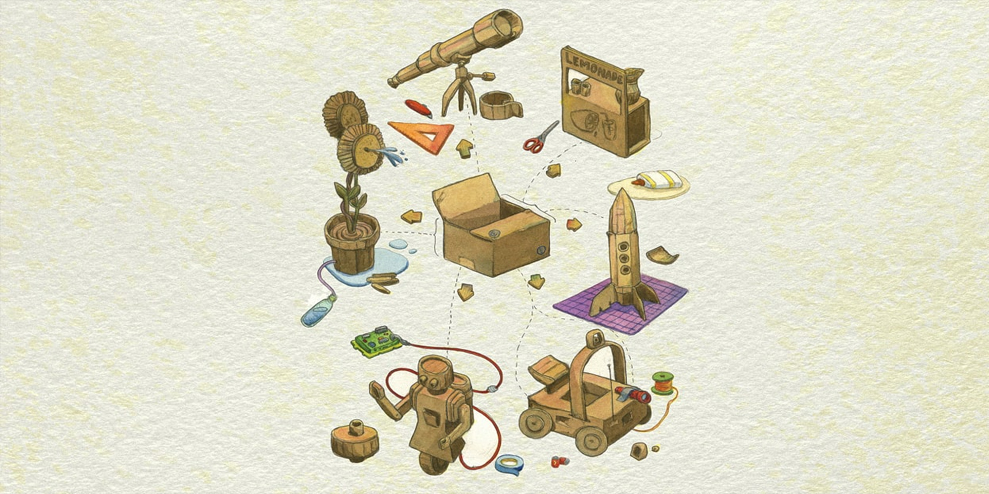A new book breaks down this necessary tool in a designer’s arsenal.
How do you close the gap between I wonder and I know? You make a prototype. A prototype is a tool that gives you a chance to investigate your ideas and explore what could, should, or would come next, whether you are designing a new product, working out a new routine, or rearranging your furniture. It’s a modest tool for the lofty goal of testing the future, or for at least testing a question you have about your future. Prototyping helps lower the stakes for exploring new questions by reducing risk—using fewer resources like time, money, and emotional commitment—especially when anxiety about outcomes might keep you from starting.
Prototyping is a primary tactic for designers, but it’s a tool that also shows up in faraway fields. Skateboarders and chefs, for example, know that being intentional doesn’t require being perfect at first. A skateboarder tries a new trick: That’s a prototype experience. A chef experiments with a new recipe: That’s a prototype experience. We know from watching both the skater and the chef that the next try comes after understanding what happened the first time. This is a strategy of repetition, not a singular performance. This is also a strategy of learning, with discovery embedded in every outcome. Through knowingly imperfect attempts, prototype experiences illuminate possibilities for your next move.
Unlike finished products ready for purchase, prototypes are imperfect and impermanent by design. Their value comes from efficiency, helping you learn the most from the fewest resources. This makes them a unique type of tool, such that the best prototype doesn’t have to be of “best-built” quality right now.
The low-resolution nature of prototypes invites a behavior of breaking the things you make. Making and breaking is how you learn through experience. This means that prototyping is provocative by nature, with an undeniable element of fruitful sabotage. It’s often misrepresented as an act of trivial trial and error or of recklessly moving fast for the sake of a crash. Sure, swiftness is a virtue, but a prototype’s job is to teach from the broken bits before fallout is let loose in the world. In some ways, that means prototyping is a slow art of figuring out by fumbling around; it takes practice to create prototypes that fail well.
The pieces and process of prototyping are often part of technical vocabulary, which can be intimidating. But prototyping is an everyday practice that’s a perfect fit for any moment when your curiosity meets an intention. Defining your prototype and considering the prototype experience from the start is effort well spent in developing the confidence to answer the big question: What am I doing?

MAKING WITH A MINDSET
Develop a few mindsets for putting all your prototyping decisions into action. That’s an almost-too-quick way to capture the breadth of concepts you’ve considered up to this point, but it’s not at all trivial. Being comfortable with how you do your work is a significant benchmark in navigating the challenges you’ll face when you move onto topics you’ve never explored or instances where you’ve never considered prototyping as an option.
When you start doing something uncomfortable or new, details can demand more attention, distracting you from focusing on your motivations. Early questions that feel like they call for immediate answers include:
What tools should I use?
How many prototypes are enough?
How will I know when I’m done?
Using a few mindsets to establish a protocol will help you figure out or improvise your way through those details as you deem them important or not. Try these three mindsets to guide your practice:
1. MAKE DO BY USING NOTHING MORE THAN IS NEEDED.
The prototyper’s art is one of making the most out of the least. The essence of the experience depends on establishing only a few details while allowing the rest to come from context and creativity in the moment. Two tactics you can use are (1) editing down to some basic elements as part of a prototype experience and (2) restraining yourself from overpreparing for every contingency.
Choose your basic details based on the core question you are asking, and save the rest for later. That’s an intentional measure of restraint to help you feel comfortable when the experiences deviate from what you thought might happen and what really happens once other people get involved. Have you ever planned or participated in a picnic? That’s an event that relies on only a few key details to start and becomes a success through workarounds and
surprise improvisation. If you find yourself fretting over details or getting too specific, remind yourself to make it a picnic—match the resources at hand with the question you are hoping to ask.
2. MAKE IT FAKE, BUT DO IT FOR REAL.
Create prototypes as physically and conceptually “big” as you can. You are trying to make the conceivable believable. Focus on emulating full-scale work while keeping a limit on your time and resources. A few distilled details can make an experience feel real and immersive, just like a theater set from a play.
The closer your prototype comes to reality, the better you will be able to understand someone’s true reactions and behaviors. Consider these two scenarios as possible prototypes:
Tell me what you would do if you found $100,000.
Here’s $100. Show me how you’d spend it.
The first approach can generate only conjecture in response, while the second can show a real result. A hundred dollars in hand isn’t trivial. It feels real because it’s not hypothetical, and the scale is significant.
3. MAKE IT AN EXPERIENCE, ALWAYS.
An experience offers a participant the chance to engage with a question or situation in a real way, through an activity of senses and emotions. This is one difference between making a prototype and conducting a survey or an interview. Make it a goal to always ask with an experience rather than just words.
An experience offers a participant the chance to engage with a question or situation in a real way, through an activity of senses and emotions. This is one difference between making a prototype and conducting a survey or an interview. Make it a goal to always ask with an experience rather than just words.
Instead of asking a new college graduate, “What is most important in your life right now?” ask with an experience: sSpend $100 in a way that is important to your life right now. The experience can expand beyond an answer like “save for the future” and focus on real details, like Where do I actually stash my savings? or Do I spend the money on gifts for friends? Maybe spend it on repairs to a bicycle for commuting to the new job? An experience will always deliver useful information that a question alone can’t cover.
You’re ready to go! With clear questions, objectives, and mindsets, you’re prepared to prototype. Everything else builds on these core components.
The story above is reprinted with permission from This Is a Prototype: The Curious Craft of Exploring New Ideas by Scott Witthoft and Stanford d.school, published by Ten Speed Press, an imprint of Penguin Random House.
Scott Witthoft works as an educator, designer, and author. With a background in forensic structural engineering, he incorporates that expertise with current pursuits in space, furniture, and product design—teaching and speaking widely. He is co-author of the book, Make Space, a tool for creating collaborative environments. He has also authored articles for the Conference Board and Harvard Business Review. His work has been featured in The Design Museum and publications such as Fast Company, Architecture and Urbanism, and Metropolis.
—
This article first appeared www.fastcompany.com
Seeking to build and grow your brand using the force of consumer insight, strategic foresight, creative disruption and technology prowess? Talk to us at +971 50 6254340 or engage@groupisd.com or visit www.groupisd.com/story

